As power grows, it becomes essential for every business to use strategies to build and develop an online presence. You can use many SEO strategies to make your website stand out in search engines. One of the popular SEO strategies lately is programmatic SEO. Google Ads has become an expensive and highly competitive field for many industries. Small businesses must make a difference in SEO to be organic and discoverable. You can drive more organic traffic by getting creative and excellent at SEO. While this may seem impossible, you can perfect your SEO with programmatic SEO.
In this context, we will show you how programmatic SEO, which we call SEO automation, works and how to apply it. If you are ready to dive into this deep learning process of programmatic SEO, let’s start right away.
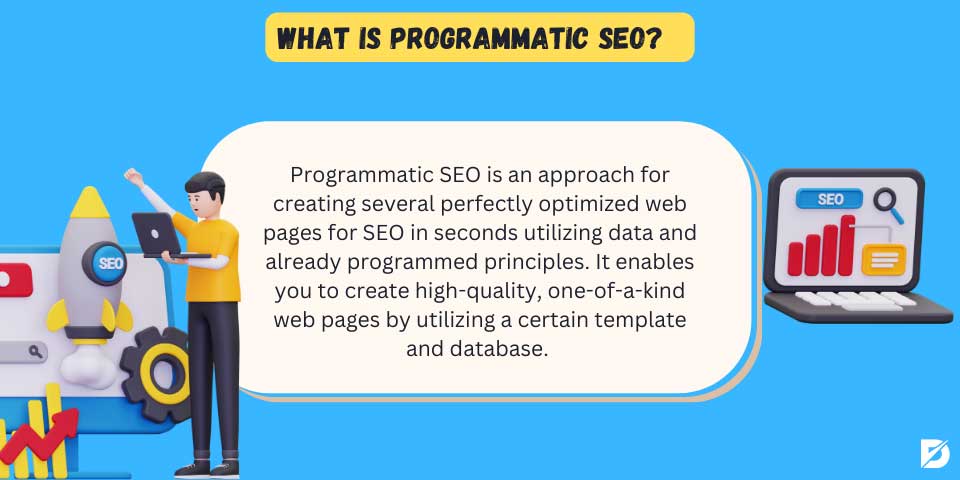
What Is Programmatic SEO?
Programmatic SEO is the strategy to create many perfectly optimized web pages for SEO in seconds, using the data you get and specific rules that have been programmed before.
It allows you to publish high-quality and unique web pages using a specific template and database. The main goal of this strategy, also known as automatic SEO, is to make the most effective pages accessible to your potential customers. With this strategy, you can drive more traffic to your website. Web design plays an important role.
You can create original content with the same depth and rigor as traditionally published high-quality content. You can create a programmatic website as small as 200 pages or as large as 4 million pages. Each page on this site can serve a different purpose in the search experience.
With this strategy, you can create a database and publish thousands of web pages by linking your page to a template. But if you only focus on programmatic optimization, you can generate thousands of spam.
If you create content programmatically, you can grow your website or generate a spam dump. Here, you can address the benefits of the automated SEO process by setting up your strategy correctly and getting professional support. We learned programmatic SEO, and now let’s see how it works.
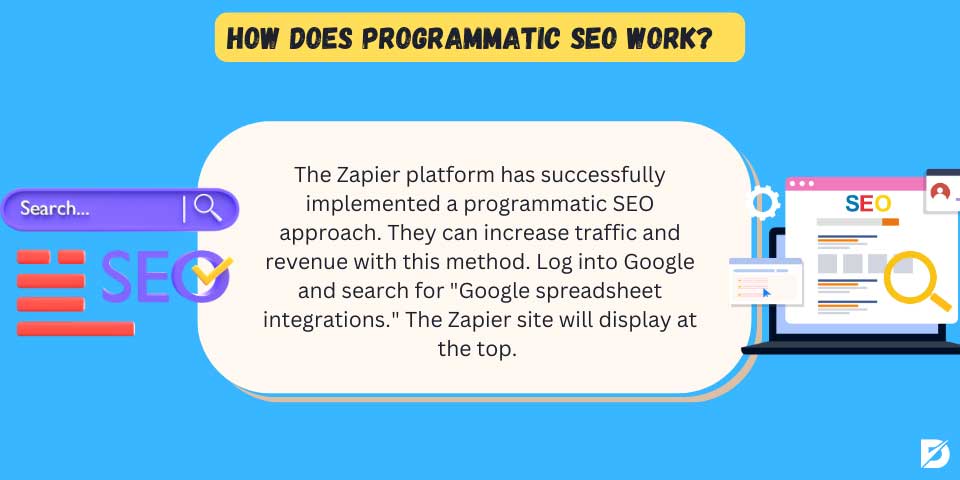
How Does Programmatic SEO Work?
With the programmatic SEO examples we will provide in this section, we will help you understand how the strategy works. We know that the Zapier platform has developed a successful programmatic SEO strategy. Thanks to this strategy, they can get more traffic and income.
If you want tools to integrate with Google spreadsheets, log in to Google and search for “Google spreadsheet integrations.” You will see the Zapier site appear at the top. When you click on the link, the application page will appear.
On this webpage, it gives you all the integrations with which you can create a Google Spreadsheet using Zapier. In this search, you can dig deeper and find pages with custom integrations, as Zapier pages are database-driven.
Let’s say you are doing concept-oriented research on the experience in question. In this case, search for “Google Sheets and concept integration.” Again, Zapier’s results will be at the top of the list. You can easily integrate Google Spreadsheets and the concept on the page you enter.
You can use Google Sheets integrations, which we have given as an example of pragmatic SEO, in all tools Zapier supports. With Programmatic SEO, you can find a lot of content that can solve your customers’ problems on a large scale. Let’s look at how it’s done now that you understand our programmatic SEO case study better.
How to Do Programmatic SEO?
You need to follow some steps to implement a programmatic SEO strategy. Let’s consider this process in detail;

Keyword Research
To create programmatic web pages, you first need to do keyword research. First, you must find the main topic and terms on your page. You must then identify modifiers and search terms related to the particular case. We recommend focusing on long-tail keywords by combining keywords and modifiers. So, it is essential to develop effective keyword-targeting strategies.
You should determine your target keywords generally and specifically. You also need to select the modifier words after the main keywords. These phrases allow you to make your main topic specific and rank for low keywords.
Primary modifiers are separate categories related to your main term. Local SEO or on-site SEO will be a primary modifier for the content you create in the SEO field. Secondary modifiers include adjectives that describe your main term. The word professional local SEO is a secondary modifier.
When determining keywords, you should prioritize long-tail keywords in programmatic SEO. These can be 3-5 words and have lower search volumes. However, the word groups allow you to attract high-quality traffic. You can achieve high-quality organic hits with programmatic SEO when many pages and targeted keywords come together. Analyze for keyword targeting strategies and plan the right strategy.
Template Design
We mentioned that the programmatic SEO process is based on a template. As a second step, you need to create the page templates. Your pages must have value for users. Deliver value by tapping into what your potential audience needs. For example, you can attract visitors in every sector with a template that compares prices.
When designing templates, including templates that are compatible with your goals. The blog template will be suitable if you create content-based pages. You can design product pages and landing page templates for selling products and services.
Integrate the dynamic approach, which is essential in SEO, into your templates. The templates you create should always contain active elements. Your pages that you will design programmatically should be different according to the keywords you are targeting, but they should all be designed in a specific structure. Failure to do so will result in pages with duplicate content.
You can include dynamic text and images in your templates to avoid duplicate content. You can easily create a conversion-based landing page using many tools.
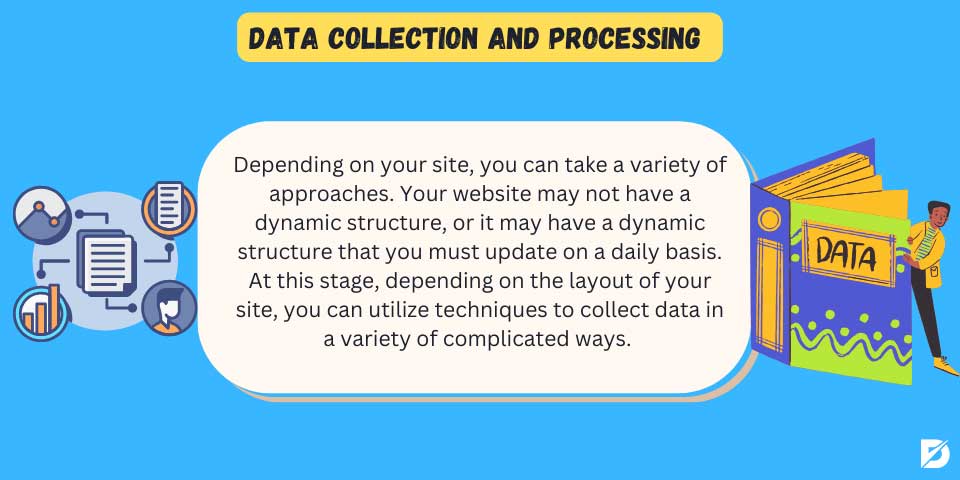
Data Collection and Processing
At this stage, you can follow different ways according to your site. Your website may not have a dynamic structure, or it may be dynamic that you need to update every day. At this point, you can use methods to collect data in different complex ways according to the structure of your site analysis. You can research websites, collect private and hard-to-access data, enter content manually, and develop user-generated content.
Content Production
If you will carry out programmatic SEO studies, you should produce content. If you want to automate this process, you can also use artificial intelligence to create or rewrite content. You can also find many AI-powered platforms that will automatically generate templates. Sidekick Contentbot.ai will provide an automatic landing page template and written content for programmatic optimization.
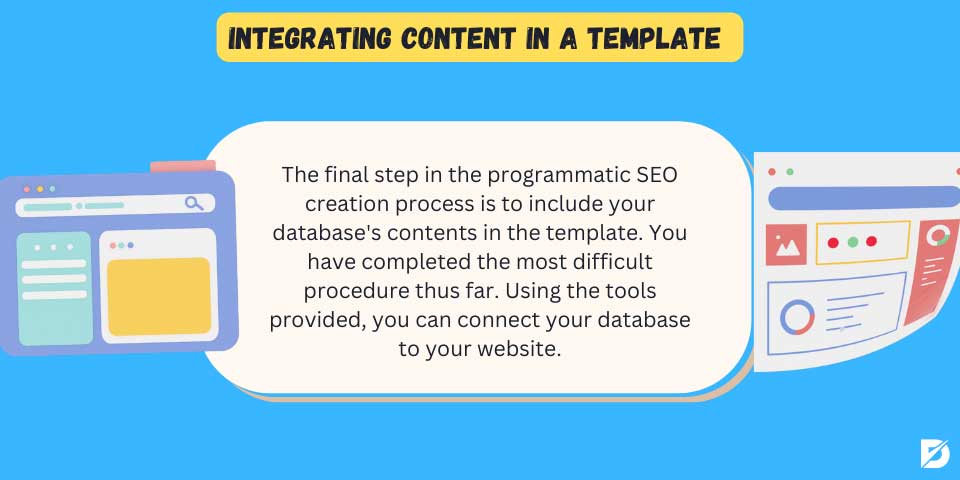
Integrating Content in a Template
The final stage in the programmatic SEO development process is to integrate the contents of your database into the template. You have passed through the most challenging process so far. Here, you can connect your database to your website using specific tools. As your database is updated with the device you use, your website is updated.
Monitoring and Editing
After performing all your processes for programmatic SEO, it is now up to performance monitoring. Test your website’s working status from all browsers and devices. Then, configure all functions such as content, template, and metadata according to the deficiencies. Tracking will give you a chance to come up with new programmatic SEO ideas. This way, you can ensure your website has the best SEO performance.
Benefits of Programmatic SEO
Programmatic SEO has yet to be well known but is becoming increasingly popular. You need to apply it professionally to perform better on your website. The benefits of programmatic SEO can be seen if you use it correctly.
If you are developing SEO strategies with this technique, let’s explain the benefits you will get;
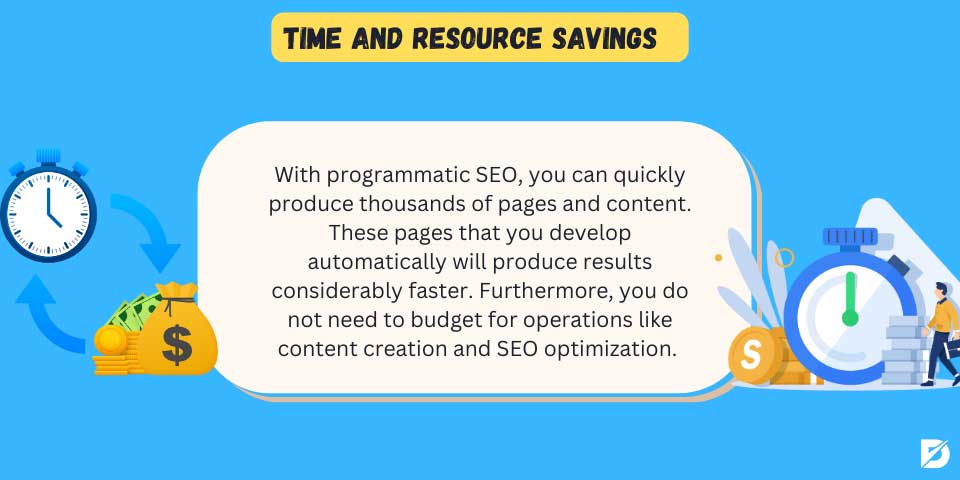
Time and Resource Savings
If you decide to produce thousands of web pages and content for your website, allocate a very high budget and plan a long working time. SEO is often a time-consuming process. At the same time, the workflow requires both resources and time.
With Programmatic SEO, you can create thousands of pages and content in a very short time. You will get results much faster from these pages that you create automatically. Moreover, you do not need to allocate resources for processes such as content production and SEO adjustments. As a result, this SEO strategy saves you time and gives you the advantage of using your resources efficiently.
Data-Based Decision Making
Those who adopt a programmatic SEO strategy run all processes based on data. First of all, keyword analysis is done when starting the SEO process. Many details are included, such as the search volumes of keywords.
The decision to find the most suitable template for your website is made as a result of the analysis. After developing a programmatic SEO strategy, you measure all results with professional tools. Then, you decide on the data you get while implementing your new strategy.
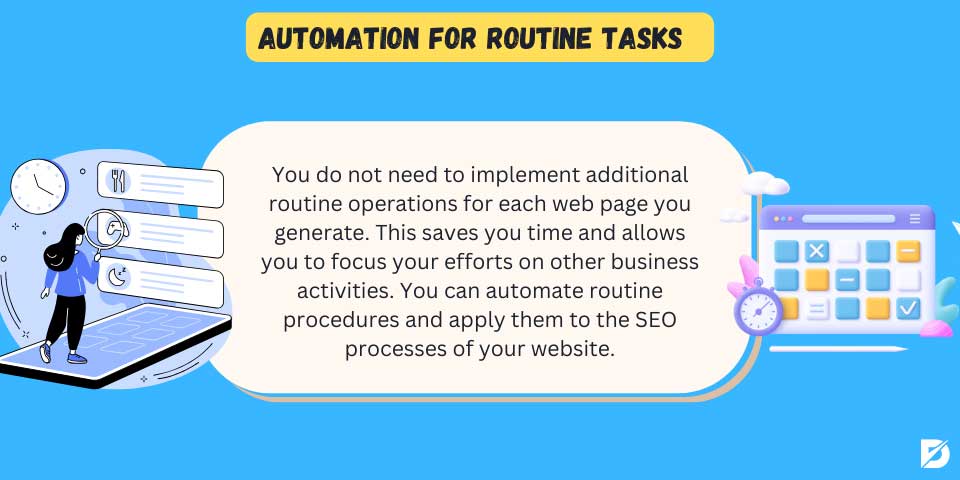
Automation for Routine Tasks
Routine but time-consuming processes such as content production, content entry, creating meta tags and descriptions, and image optimization are done automatically in the SEO process. In programmatic SEO, where you can make thousands of web pages and content, all of the routine tasks occur with the automation system.
You do not have to implement extra routine processes for all the web pages you create. This saves you time and allows you to spend energy on different business processes. You can automate everyday tasks and apply them to your website’s SEO processes. In this process, you can program routine tasks and have the system implement them. You can automate your processes with the right programmatic SEO tools.
Consistent Content Presentation
When you use the automatic SEO system to create thousands of web pages on your website, you can have unlimited content on the same topic. A visitor can find all the information he wants on your website thanks to the quality and original content. With consistent content delivery, you can become one of the best-known websites in your niche.
If you are selling products and services, you can add content on any subject related to your products and services on your blog page to your website with this system. In this way, you can create different content to cover various topics on the subject you want.
Multi-page websites run the risk of creating duplicate content. Thanks to the automated system, you can avoid the same content and have a consistent blog section. Especially for content marketing, programmatic SEO provides a considerable advantage. For this, focus on delivering flawless content delivery automation.
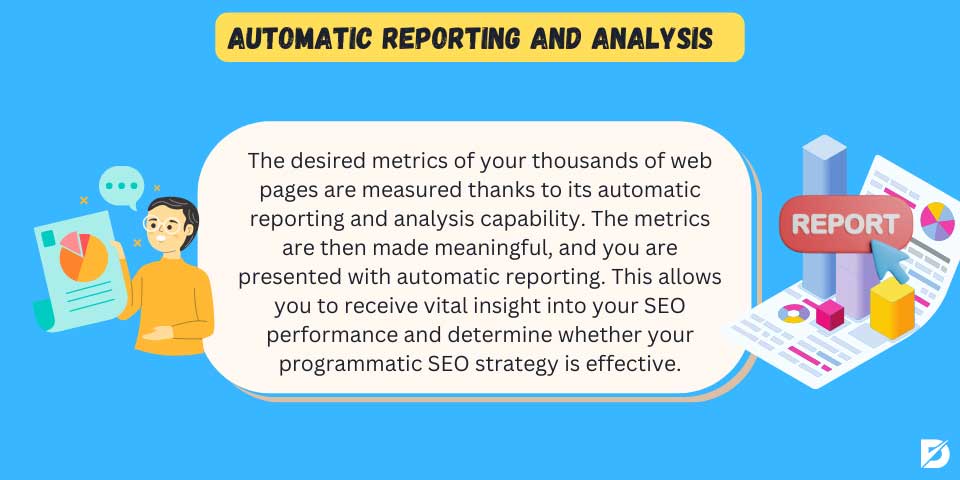
Automatic Reporting and Analysis
Monitoring the performance of all web pages and reporting analysis results on websites with many pages will be challenging. You know that in programmatic SEO, you have thousands of pages. But have you ever thought about how you can analyze and write all these pages and measure the effectiveness of your SEO?
Thanks to its automatic reporting and analysis feature, the desired metrics of your thousands of web pages are measured. Then, these metrics are made meaningful, and automated reporting is presented to you. This way, you can gain valuable insight into your SEO performance and see if your programmatic SEO strategy works. At the same time, you can obtain data that you can use in programmatic SEO to develop new techniques in the future.
Automatic Site Inspection
Many processes, such as site errors and duplicate content on your website, hurt your website’s SEO performance. At this point, you need to perform an SEO audit of your website. This cannot be easy manually if you have a website with thousands of pages programmatically.
Your website is automatically audited with the automation you use while doing programmatic SEO. This way, you can easily find and correct incorrect pages on your website. At the same time, you save time and energy on website auditing.
Disadvantages of Programmatic SEO
Programmatic SEO may have come to you this far as the perfect system. Having quality content and web pages to boost your SEO performance with one click may sound reasonable. Undoubtedly, implementing programmatic SEO brings many benefits to your website and business. However, this strategy also has some disadvantages.
Please familiarize yourself with the disadvantages of programmatic SEO before you decide to get started. Let’s consider the negative aspects of your business and website;
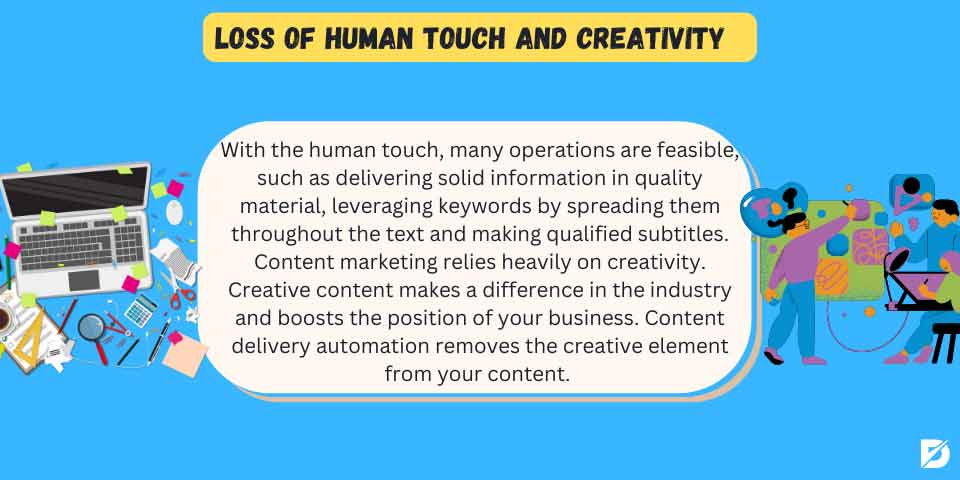
Loss of Human Touch and Creativity
Quality content always comes from the hands of expert, competent, and qualified content writers in this field. Many processes, such as providing solid information in quality content, using keywords by spreading them throughout the text, and creating qualified subtitles, are possible with the human touch.
Creativity is an essential aspect of content marketing. Creative content makes a difference in the industry and strengthens your brand’s position. Content delivery automation takes the creativity out of your content. If an author deems it necessary, he reads the content with the human eye and can use strategies such as listing content or giving examples. This is not possible with automatically generated content.
In SEO processes, SEO experts can make special arrangements according to the situation and their experience. However, since the whole process is automated in programmatic SEO, an expert touch cannot be made, and it is impossible to develop and implement creative solutions. You can also apply a semantic programmatic SEO strategy to improve content quality.
Dependency on Technology Reliability
If you apply an automatic SEO strategy, many processes are executed as the system commands. Artificial intelligence, especially during content production, leads to information being received only as it is on the Internet.
When creating thousands of pages with programmatic SEO, it is impossible to audit them all for reliability and quality. For this reason, you do not know how high-quality content the system will create, in which field it will provide correct information, and whether it will contain valid and up-to-date information. In this case, you depend only on the system’s reliability and up-to-dateness.
For a website to attract users, it has to offer helpful information. However, all your effort and investment will only be worthwhile if the system can provide helpful content related to your industry and content that will convince your potential audience to be found.
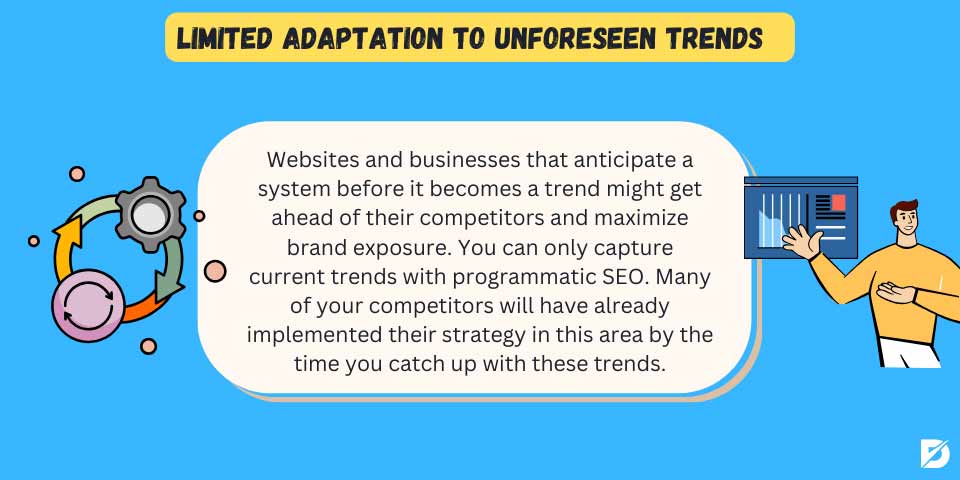
Limited Adaptation to Unforeseen Trends
Information is changing rapidly in the digital environment, and new trends are constantly emerging. Sometimes, a movement loses its importance within a few hours, and a new one occurs. Websites and businesses that foresee a system before it becomes a trend can get ahead of their competitors and increase their brand awareness to the maximum level.
With programmatic SEO, you can only catch current trends. When you catch up with these trends, many of your competitors will have already implemented their strategy in this area. You should do a competitor analysis. Once there is knowledge and initiative in this field on the Internet, the automated system will handle it. For this reason, it is strict with programmatic SEO to anticipate a trend and develop strategies to adapt to it. If you have an industry where you can stand out by catching the directions, this SEO strategy may be risky for you.
Excessive Optimization Risk
Google requires websites to meet the specified ranking criteria to rank higher on the search results pages. At this point, it is necessary to implement the correct optimizations. Only optimizing or doing well will positively affect your site’s search engine performance.
A qualified search engine like Google will also negatively evaluate excessive artificial optimization. It notices if a website or page has been highly skilled and systematically optimized.
For example, if strategies such as excessive keyword passing are applied in content, this is a negative SEO evaluation. Programmatic SEO designs content based on an automatically generated template and can sometimes go overboard with optimizing. In this case, Google may evaluate your website negatively, and your ranking may be negatively affected.

Potential for Algorithm to be Misinterpreted
The Google algorithm crawls all websites and interprets websites based on specific features. It then ranks these websites according to certain ranking factors to bring them in front of relevant users.
Google can misinterpret your website in programmatic SEO. In this case, your website will not reach your target audience or may be perceived as spam. It will only do you good if your website ranks on the right keyword.
Lately, Google has been paying much attention to the crawl budget. You are given a crawl budget based on the number of pages on your website and the system status. According to this crawl budget, search engine bots crawl a certain number of your pages at a particular time. When you have thousands of pages at once, Google may have difficulty indexing your website, and the algorithm may misinterpret it.
Highlight backlinks and internal links and focus on reducing errors with XML sitemap generation. This way, search engine bots navigate your website more efficiently and understand your page. In this way, you can prevent the algorithm from misinterpreting your website.
Privacy and Data Security Concerns
There are some programs to use when investing in a programmatic SEO strategy. At the same time, since your website is extensive, it becomes difficult to follow all the processes. At this point, privacy and data security concerns also arise.
Some applications may violate data security in your tools or programs. For this reason, you should carefully choose the tools you will work with.
You also need to improve programmatic SEO against privacy violations of your users or some private information on your website. That’s why you should take extra privacy and data security measures.
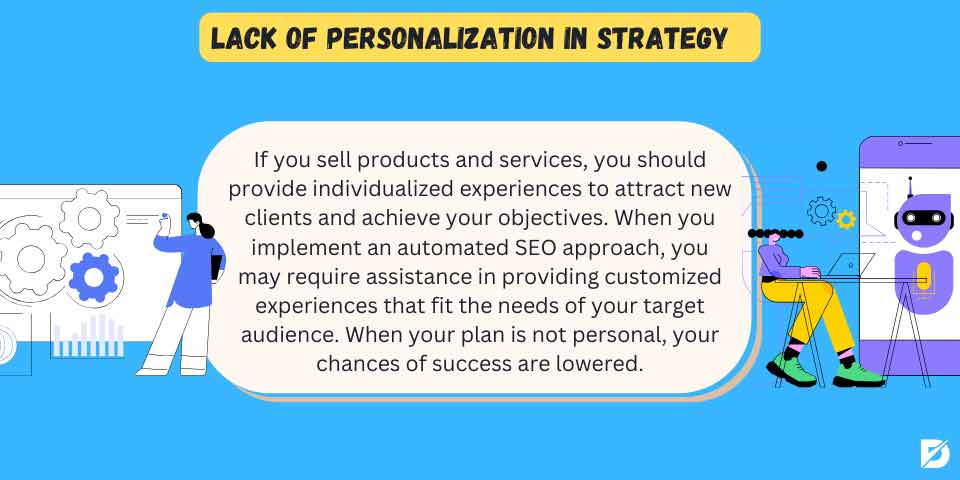
Lack of Personalization in Strategy
It would help if you focused on user experience in your SEO strategy. Whatever Google changes, its primary purpose is to provide the best user experience. For this reason, you should include personalization in your SEO strategy.
If you sell products and services, you should offer personalized experiences to attract potential customers and reach your goals. When you adopt an automated SEO strategy, you may need help to provide customized experiences that meet the demands of your target audience.
When your strategy is not personal, the probability of success is also reduced. Many businesses seek ways to eliminate the need for more customization in their programmatic SEO strategy.
Misinterpreted Analytics
You work data-driven in programmatic SEO. However, one of the limitations of this strategy is the acquisition of data that will not work for you or will mislead you. In this case, you can also make mistakes in interpreting the data.
You will only succeed at the analysis point if you interpret the data you obtained in your SEO performance. In this case, you cannot know whether your strategy is working, and you may develop the wrong methods for your future SEO efforts.
To be successful in SEO, it is necessary to analyze and make the proper analysis. Programmatic SEO leads to misinterpreted analytics due to some limitations. This means a waste of both time and budget.
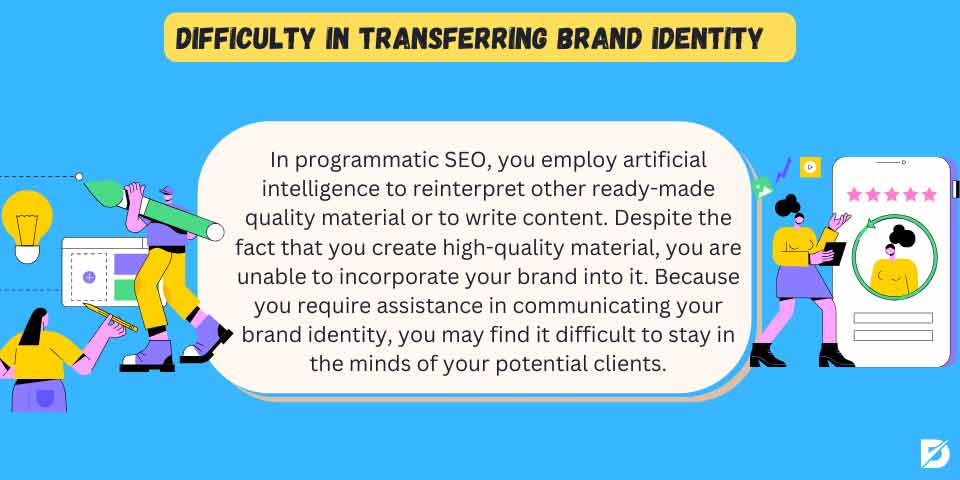
Difficulty in Transferring Brand Identity
The more people who carry out commercial activities to promote their brand in the digital environment, the more successful they will be. People are now focusing on choosing a brand with a qualified identity. For this, you need to tell your brand story accurately and effectively.
In programmatic SEO, you use strategies for reinterpreting other ready-made quality content or writing content using artificial intelligence. Although you produce quality content, you cannot integrate your brand into the content.
Because you need help conveying your brand identity, you may find it challenging to stay in the minds of your potential customers. You may lose your advantage over competitors when you cannot get your brand identity. Programmatic SEO has some limitations at this point.
Limited Emotional Intelligence in Automation
It would help if you had more than quality content to attract your target audience to your website or persuade potential customers to buy products and services. No matter how accurate and adequate information people get, they will want to establish an emotional connection with a brand.
When you activate people’s emotional intelligence, they will want to spend time on your website and be willing to have a buying experience. When you create content based on automation, you may need more activating emotional intelligence.
You can only establish an emotional connection with the content and pages you automatically create up to a certain point.

Loss of Organic Link Building Opportunities
In SEO studies, you can get the opportunity to establish many organic links with your audience. Follow your pages privately and constantly interact with your potential audience.
Programmatic SEO allows you to have a website with thousands of web pages. However, you can only track some page interactions on a website with such many pages. At this point, you may miss out on organic link-building opportunities.
Considerations for Programmatic SEO
When you adopt a programmatic SEO strategy, you should operate this process correctly. This term is an emerging concept. Experts view the programmatic SEO process as creating thousands of landing pages to drive traffic from long-tail keywords.
Programmatic SEO can be described as a data-driven optimization process. Because this strategy has many limitations, you must put it into practice very carefully. We will give some details about what to consider for programmatic SEO;

First, you must structure your programmatic SEO strategy to make sense for the user and Google bots. As you create millions of pages with different combinations, design them all to be easy to browse and navigate. In particular, try to map your pages in a logical order. You should constantly do due diligence on in-site link structure and technical SEO and ensure that Google uses its crawl budget most efficiently. Test your structured data!
In programmatic SEO, you should also plan your content strategy on a fine line. You need to offer users rich, high-quality content with a vast database. In some cases, offering simple landing pages can also be extremely useful. Refrain from filling landing pages with heavy content. Plan a simple experience for as many users as possible. You can then redirect them by adding helpful links and some article referrals. Focus on adding FAQs to your content to increase the user experience. In content production, you should avoid using ChatGPT content directly and create the content in the most qualified ways possible.
If you’re starting programmatic SEO on a new website, test various variations, theories, and tools. Changing the strategy on a corporate website can have a negative impact. Therefore, it is a much better approach to start and specialize programmatic SEO on new websites.
In the automatic SEO you apply on your website, you should also guide the search engine bots and create unique SEO settings. H1, H2, etc., on your web page. Title structure, page structure, and titles should be meaningful. Inaccuracies in page markups will fail your programmatic SEO strategy. It would help if you tried to act by analyzing SERP results, especially in creating your titles and SEO data.
Schema markup has been among the most effective strategies at Google lately. There are many schemes, and in programmatic SEO, the FAQ scheme can be one of the best ones to work with. You can also use breadcrumbs to improve the structure and experience of your website. In programmatic SEO, you can strengthen your SEO by scaling site-wide and entity-wide on similar page types.
You should monitor your website using qualified software if you have hundreds of thousands of pages. If you will implement a programmatic SEO strategy, you should find capable software. With suitable software, you can find and optimize all SEO errors. In this way, you can remove some of the limitations of the programmatic strategy.
Start programmatic SEO with as many variants as possible. Build a robust database and design a versatile template. This way, you can create thousands of unique page combinations. This way, you can automate the page creation and use programmatic SEO technology to scale.
No SEO strategy ends with the publication of your page. This is where the natural SEO starts. You can only find perfection with proper measurement and adjustments in your SEO. Monitor your performance, understand your progress, and develop new strategies for indexing and increasing rankings. For this, use tools such as Google Search Console and SemRush.
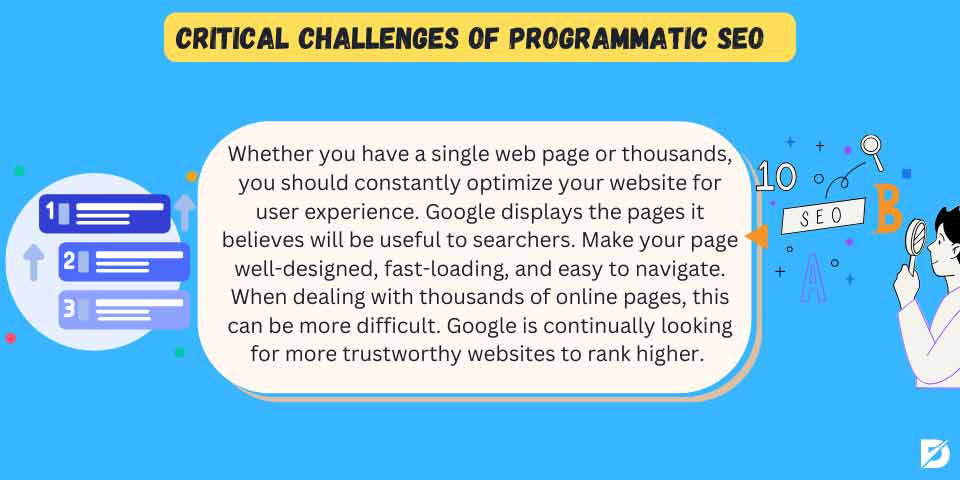
Critical Challenges of Programmatic SEO
With Programmatic SEO, you have dozens of pages on your website. When you check all the pages, the performance of the pages and your SEO efforts can be well-spent. While it saves time and money, there are some programmatic SEO challenges.
We will cover these challenges and solutions at a basic level. In programmatic SEO, you avoid what Google calls thin content. According to Google, fine content affiliate pages are pages where product descriptions and reviews are copied from the original vendor, with no actual content or added value. Google always displays the pages that contain the most valuable content to searchers. Having a title and few links on your page will not make you successful.
Whether a single web page or thousands of web pages, you should continually optimize your website for user experience. Google lists the pages it believes searchers will find helpful. Work to make your page well-designed, fast-loading, and navigable. This can be more difficult when it comes to thousands of web pages.
Google always wants to rank more trusted sites. Therefore, domain authority will be low if you do programmatic SEO on a new website. This negatively affects the success of your SEO work. To avoid this, you can manually create 5-10 high-quality blog posts in addition to your programmatic web pages. This strategy will increase domain authority. Also, be aware of Google Ads management.
Another challenge of programmatic SEO is crawlability. In a domain with thousands of web pages, Google may need to know which page to prioritize exploring. If Google can’t find your page, it won’t be able to rank it. At this point, you can overcome the limitation with a very solid internal linking strategy. Additionally, you can have your web pages categorized using an HTML sitemap. A sitemap works very well on websites with millions of pages. For this, you should plan an excellent algorithmic optimization process.
Programmatic landing pages are often visually oriented. Graphics, videos, and images are included, but text content should not be forgotten. Descriptive texts have a significant impact on ranking. Pages with written content are seen as good content in the eyes of Google. Therefore, the value decreases, and the order becomes negative. Create programmatic SEO automation where you will present all content types together.
The possibility of duplicate content or duplicate content is also widespread in programmatic SEO. For this, you can free your automated SEO efforts from this limitation by using an online duplicate content checker.
How to Try Programmatic SEO Yourself
Programmatic SEO allows you to capture the most value. This value is the return on investment, and you can maximize your SEO performance by implementing a successful strategy. If you implement the programmatic SEO strategy yourself, the hard part is just getting the system up and running. Afterward, there is usually no need for human intervention.
If you want to start programmatic SEO, follow the steps above. You can use SEO automation tools such as Airtable, Webflow, and Whalesync. You can also take a programmatic SEO course.
Programmatic SEO could be a better strategy for your website. However, it is a strategy by which you can quickly increase the exposure of your website at a low cost. You can always contact us if you have a question about this and need support. Learn programmatic SEO from our resources and start right away. You can always consider getting professional support for automation in SEO. You can call us for this.
Frequently Asked Questions About
Programmatic SEO involves automatically designing and optimizing thousands of web pages based on user behavior based on specific data patterns. Traditional SEO has a process of manually doing particular optimization strategies and steps. Instead of manual methods in traditional SEO, there is an automation process in programmatic. In programmatic SEO, thousands of pages are created in a few minutes, while conventional SEO takes a lot of time. While the pages of programmatic SEO are designed according to a specific template, traditional SEO uses manual instant template design. At the same time, if you are going to do programmatic SEO, you should have good technical knowledge and understand SEO well.
Programmatic SEO is a cost-effective strategy in the long run. However, first of all, it is necessary to establish the system, create the technological infrastructure, and invest in training personnel experienced in this field. It is also only a suitable strategy for some businesses. Checking can be complex as you have thousands of pages. All efforts can only go to waste if the right data and automation systems are installed.
In programmatic SEO, the need for humans is much less. It is possible to carry out SEO processes by employing much less staff. However, human intervention is necessary to oversee programmatic SEO, monitor the website, and remove some limitations. This is why programmatic SEO can only partially lace human participation.
Programmatic SEO is only suitable for some websites. Content on web pages must be relevant and valuable. Your investment in programmatic SEO may only be well-spent if the website offers helpful and informative content. It is a suitable strategy for websites that will benefit from content marketing. You can understand it is the proper application for your business with programmatic SEO services.
Programmatic SEO automates the content creation process. You can have a large number of pages and content in a short time. However, in the content creation process, you need to set up a system where you can create quality content. You should avoid duplicate content and produce functional, quality, and original content.
Programmatic SEO can work for all types of SEO. You can also use this strategy in local SEO studies. Identify relevant keywords. Afterward, you can optimize your website for local search experiences with programmatic SEO after performing Google My Business listing optimizations. Moreover, you can get successful results in a shorter time in local SEO. With the right strategy, you can maximize the search engine visibility.
There are some ethical considerations in programmatic SEO. At this point, you should be careful about using the content prepared by your competitors during content production. At the same time, although you use an automatic system in SEO, you should play by the rules. You can apply any strategy in case you will not be penalized by Google and other search engines. As long as you don’t steal from your competitors, get a punishment, and use unethical SEO, you can do programmatic SEO however you want.
Programmatic SEO can be thought of as a set-and-forget approach. On the one hand, this thinking can be accepted as correct. On the other hand, even if you do programmatic SEO, you should constantly monitor performance. In programmatic SEO, creating and optimizing web pages is automated. However, you should monitor regular performance, make the necessary interventions, and constantly monitor your website. There are many programmatic SEO tools you can use for this.





No comments to show.